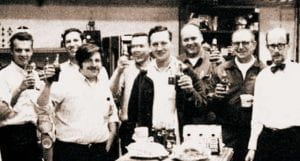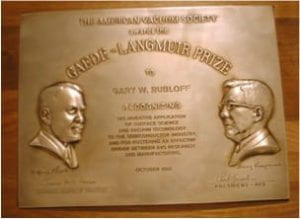Synopsis
Gary Rubloff is Distinguished University Professor and Minta Martin Professor of Engineering at the University of Maryland (UMD), with primary appointments in Materials Science and Engineering, the Institute for Systems Research, and the Institute for Research in Electronics and Applied Physics. Following his PhD in physics at U. Chicago and a postdoc at Brown U., he held research and research management positions at IBM Research Yorktown Heights in Physical Sciences, Silicon Technology, and Manufacturing Research, where his leadership in ultraclean integrated semiconductor processing and diagnostics led to his receipt of the AVS Gaede-Langmuir Prize in 2000. He is a Fellow of the American Physical Society and the American Vacuum Society.
During 1993-1996 he was Associate Director of the Center for Advanced Electronic Materials Processing at NCSU and Professor in ECE. He joined UMD in 1996, where he was Director of the Institute for Systems Research, an NSF Engineering Research Center, until 2001. He served as the founding Director of the Maryland NanoCenter (www.nanocenter.umd.edu) from 2004 to 2018. In 2009 he and Prof. Sang Bok Lee initiated Nanostructures for Electrical Energy Storage (www.efrc.umd.edu), a DOE Energy Frontier Research Center, where Rubloff served as Director from 2009 to 2020. He was a member of the DOE Basic Energy Sciences Advisory Committee (BESAC), a Federal Advisory Committee, from 2013 to 2018 and participated and led a variety of BESAC activities.
Professor Rubloff has published over 300 papers and holds 27 U.S. patents, with his research spanning a diverse set of topics, including surface and solid state science, electronic materials and processing, real-time sensing/metrology and advanced process control, biofabrication and biomicrosystems for metabolic engineering and biological signaling, nanoscale processes and atomic layer deposition, and multicomponent multifunctional nanostructures for energy applications.
Selected historical highlights
Birth of synchrotron radiation science. Prof. Rubloff’s PhD thesis research was a milestone in the development of synchrotron radiation physics and applications. His thesis research in Prof. Hellmut Fritzsche’s group at the University of Chicago involved far-ultraviolet optical properties of ionic crystals, measured using synchrotron radiation. This was done at the early dedicated electron storage ring Tantalus I at the University of Wisconsin, which represents the U.S. forerunner for the numero us advanced synchrotron facilities now in place in the U.S. and worldwide. A 2008 Physics Today article by Giorgio Margaritondo featured this early history, showing the Chicago experimental setup and a photo of users and staff celebrating the first Tantalus I data on August 7, 1968, by postdoc Ulrich Gerhardt and graduate student Gary Rubloff. First publications appeared from Fred Brown’s U. Illinois group and Hellmut Fritzsche’s U. Chicago group in 1970-71, setting the stage for rapid growth of a broad spectrum of synchrotron-radiation-based techniques and applications from solid state physics to nanoscience, applied physics and engineering, biology and medicine, and chemistry.
us advanced synchrotron facilities now in place in the U.S. and worldwide. A 2008 Physics Today article by Giorgio Margaritondo featured this early history, showing the Chicago experimental setup and a photo of users and staff celebrating the first Tantalus I data on August 7, 1968, by postdoc Ulrich Gerhardt and graduate student Gary Rubloff. First publications appeared from Fred Brown’s U. Illinois group and Hellmut Fritzsche’s U. Chicago group in 1970-71, setting the stage for rapid growth of a broad spectrum of synchrotron-radiation-based techniques and applications from solid state physics to nanoscience, applied physics and engineering, biology and medicine, and chemistry.
Surface science leads to ultraclean integrated processing. Prof. Rubloff’s first research transition was his evolution from solid state physicist to surface scientist, which began during his postdoc at Brown University physics and culminated during his early years at IBM Research, Yorktown Heights, NY. At IBM his photoemission studies migrated from organic molecule reactions on transition metal surfaces (as important in catalysis) to semiconductor surface, interface, and materials science beginning with silicide formation. At this point he recognized the benefit of combining materials synthesis and processing techniques with in-situ ch aracterization so that controlled interfaces and materials reactions could be studied in their pristine state, with minimal contamination, corrosion, etc. from ambient exposure. This led to an emphasis on the methodology as “ultraclean, integrated processing” and to the development of sophisticated facilities which applied the approach to chemical and physical vapor growth and deposition as well as dry etching in his group and others he managed. As one of the pioneers in this methodology, he was awarded the AVS Gaede-Langmuir Prize in 2000. The physical integration of experimental components required for ultraclean integrated processing made these laboratories into research prototypes for a new generation of semiconductor manufacturing equipment, namely “cluster tools” which combine multiple chambers and employ robotics to move Si wafers between the chambers where process sequences take place, without exposure to room ambient. An extended interview about this evolution is available here. He has continued this approach in the NEES EFRC, as is evident in the description of the ANSLab facility.
aracterization so that controlled interfaces and materials reactions could be studied in their pristine state, with minimal contamination, corrosion, etc. from ambient exposure. This led to an emphasis on the methodology as “ultraclean, integrated processing” and to the development of sophisticated facilities which applied the approach to chemical and physical vapor growth and deposition as well as dry etching in his group and others he managed. As one of the pioneers in this methodology, he was awarded the AVS Gaede-Langmuir Prize in 2000. The physical integration of experimental components required for ultraclean integrated processing made these laboratories into research prototypes for a new generation of semiconductor manufacturing equipment, namely “cluster tools” which combine multiple chambers and employ robotics to move Si wafers between the chambers where process sequences take place, without exposure to room ambient. An extended interview about this evolution is available here. He has continued this approach in the NEES EFRC, as is evident in the description of the ANSLab facility.
